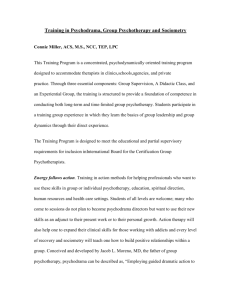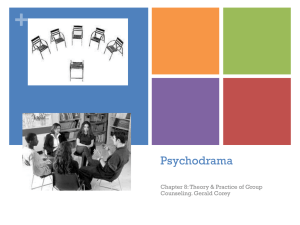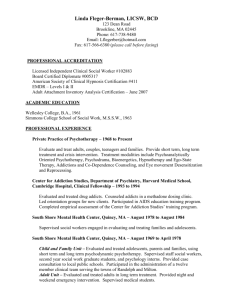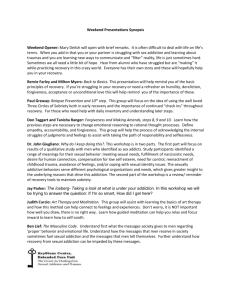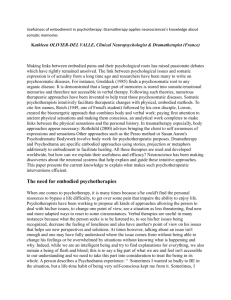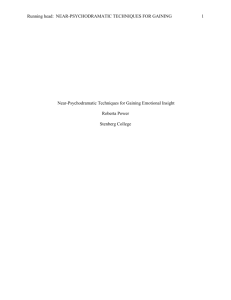Benefits, Limitations, and Potential Harm in Psychodrama (Training)
advertisement
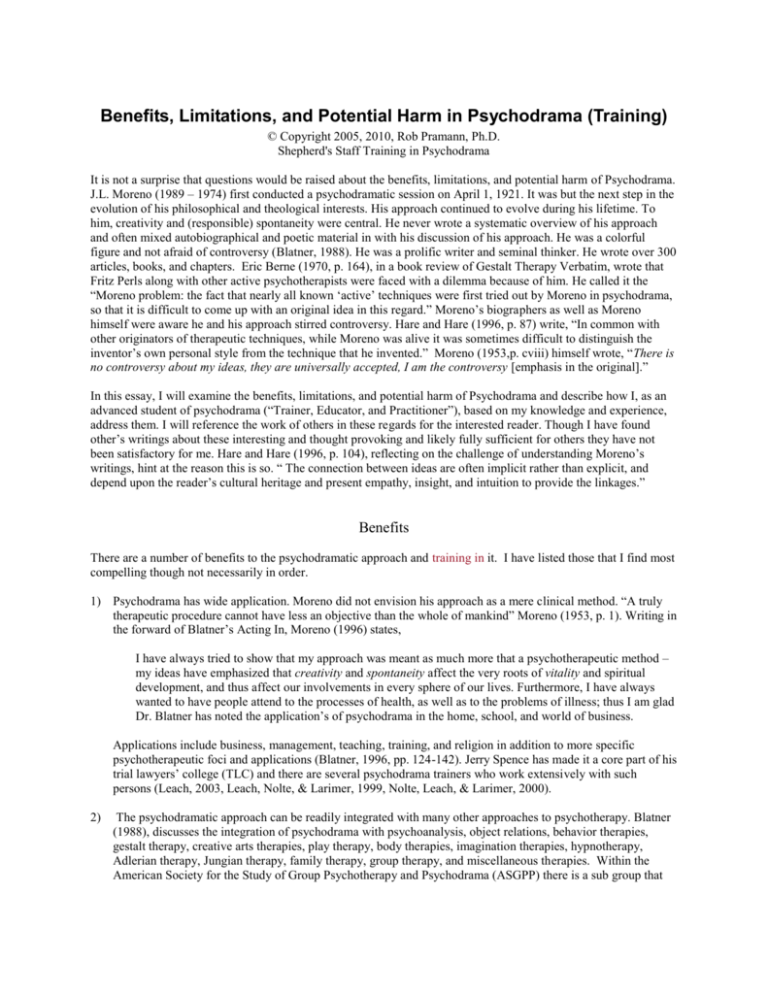
Benefits, Limitations, and Potential Harm in Psychodrama (Training) © Copyright 2005, 2010, Rob Pramann, Ph.D. Shepherd's Staff Training in Psychodrama It is not a surprise that questions would be raised about the benefits, limitations, and potential harm of Psychodrama. J.L. Moreno (1989 – 1974) first conducted a psychodramatic session on April 1, 1921. It was but the next step in the evolution of his philosophical and theological interests. His approach continued to evolve during his lifetime. To him, creativity and (responsible) spontaneity were central. He never wrote a systematic overview of his approach and often mixed autobiographical and poetic material in with his discussion of his approach. He was a colorful figure and not afraid of controversy (Blatner, 1988). He was a prolific writer and seminal thinker. He wrote over 300 articles, books, and chapters. Eric Berne (1970, p. 164), in a book review of Gestalt Therapy Verbatim, wrote that Fritz Perls along with other active psychotherapists were faced with a dilemma because of him. He called it the “Moreno problem: the fact that nearly all known ‘active’ techniques were first tried out by Moreno in psychodrama, so that it is difficult to come up with an original idea in this regard.” Moreno’s biographers as well as Moreno himself were aware he and his approach stirred controversy. Hare and Hare (1996, p. 87) write, “In common with other originators of therapeutic techniques, while Moreno was alive it was sometimes difficult to distinguish the inventor’s own personal style from the technique that he invented.” Moreno (1953,p. cviii) himself wrote, “There is no controversy about my ideas, they are universally accepted, I am the controversy [emphasis in the original].” In this essay, I will examine the benefits, limitations, and potential harm of Psychodrama and describe how I, as an advanced student of psychodrama (“Trainer, Educator, and Practitioner”), based on my knowledge and experience, address them. I will reference the work of others in these regards for the interested reader. Though I have found other’s writings about these interesting and thought provoking and likely fully sufficient for others they have not been satisfactory for me. Hare and Hare (1996, p. 104), reflecting on the challenge of understanding Moreno’s writings, hint at the reason this is so. “ The connection between ideas are often implicit rather than explicit, and depend upon the reader’s cultural heritage and present empathy, insight, and intuition to provide the linkages.” Benefits There are a number of benefits to the psychodramatic approach and training in it. I have listed those that I find most compelling though not necessarily in order. 1) Psychodrama has wide application. Moreno did not envision his approach as a mere clinical method. “A truly therapeutic procedure cannot have less an objective than the whole of mankind” Moreno (1953, p. 1). Writing in the forward of Blatner’s Acting In, Moreno (1996) states, I have always tried to show that my approach was meant as much more that a psychotherapeutic method – my ideas have emphasized that creativity and spontaneity affect the very roots of vitality and spiritual development, and thus affect our involvements in every sphere of our lives. Furthermore, I have always wanted to have people attend to the processes of health, as well as to the problems of illness; thus I am glad Dr. Blatner has noted the application’s of psychodrama in the home, school, and world of business. Applications include business, management, teaching, training, and religion in addition to more specific psychotherapeutic foci and applications (Blatner, 1996, pp. 124-142). Jerry Spence has made it a core part of his trial lawyers’ college (TLC) and there are several psychodrama trainers who work extensively with such persons (Leach, 2003, Leach, Nolte, & Larimer, 1999, Nolte, Leach, & Larimer, 2000). 2) The psychodramatic approach can be readily integrated with many other approaches to psychotherapy. Blatner (1988), discusses the integration of psychodrama with psychoanalysis, object relations, behavior therapies, gestalt therapy, creative arts therapies, play therapy, body therapies, imagination therapies, hypnotherapy, Adlerian therapy, Jungian therapy, family therapy, group therapy, and miscellaneous therapies. Within the American Society for the Study of Group Psychotherapy and Psychodrama (ASGPP) there is a sub group that specifically focuses on psychoanalytic application. An edition of the Society’s journal (Treadwell & Kumar, 2002) focused on cognitive applications. 3) Psychodrama can be used with a variety of clinical populations and foci. These include adults, children, adolescents, the elderly, couples, families, therapy groups, business groups, church and community groups, mental health, addiction, mental retardation, other disabilities, delinquency, criminal justice, organizational development, trauma, etc. (Blatner, 1988, pp. 133-143, Hirschfeld & McVea,, 1998, Holmes & Karp, 1991, Kellerman & Hudgins, 2000). There is a link from the ASGPP website to a comprehensive searchable bibliography, last updated in 2004, with over 5,000 entries (http://www.asgpp.org) that is helpful in locating articles on psychodrama with certain populations or foci. 4) Psychodrama can serve as a one-session or brief intervention (Naar, 1990). In a search of the above biography, prior to it’s last update, this clinician found 96 matches for “brief, short term, short-term,” and “session” of which 17 described brief interventions. 5) Psychodrama is commonly used as a part of or to supplement individual, couple, family, or group therapy or other therapy format (Blatner, 2009, Compernolle, 1981, Hirschfeld & McVea, 1998, Kipper, 2005). It can help to move a client or patient past an impasse or determine if they are ready for discharge from treatment by addressing an anticipated difficult situation. 6) Psychodrama represents a full development of role-playing, role-playing applications, and their implementation. Though role-playing is often talked about, outside of psychodrama it has not frequently been studied as an intervention. Assertiveness training is the only exception known to this clinician. A psychodramatic roleplaying encounter is ideal for preparing an individual for an encounter with a friend or family member, work colleague, or (potential) employer. 7) Psychodrama role-playing teaches empathy skills par excellance. Role-reversal in psychodramatic encounter was understood by Moreno to be central to his method. In psychodrama, participants quite literally put themselves in the place of the other person and come to experience the world from their point of view. Thus psychodrama has much to offer the developing (or even seasoned) mental health professional. In addition, persons that are either deficient in empathy (perpetrators of sexual abuse or domestic violence), persons desiring to develop it to enhance their professional functioning (attorneys), or those merely trying to understand an interpersonal relationship difficulty will benefit from this aspect of psychodrama. 8) Psychodrama is a powerful and effective mode of communication. Moreno (1972, p. a.) wrote, “Psychodrama can be defined as the science that explores truth by dramatic methods.” If a picture is worth a thousand words, what is the value of a motion picture reenactment of what happened? The psychodramatic approach engages individuals and groups on multiple levels through a combination of channels: visual, auditory, kinesthetic, intuitive, intellectual, emotional, relational, actional/behavioral, etc. This approach can be of particular value in working with persons with difficulties related to verbal communication including children, adolescents, men, the developmentally delayed, and the intellectually challenged. In terms of human development, actions provide the earliest mode of communication. Clinically, I have found that often a person’s vocabulary and conceptualization suggest one thing but when what has been described is enacted, it is clear something else was intended. Similarly, what a person understands is clear when they can show it in actions and not just words. 9) Psychodrama can be used to address a wide variety of issues including those in the past, present, and future, or those that involve the internal (intra-psychic) conflict or interpersonal realm. It can address that which Moreno called “surplus reality,” those issues related to what one could have, should have, and would have done. It can be used to effectively address dreams and hallucinations. It can be used to address concerns related to “the church, the government” or “God” in a direct sort of way. It can be used to assist a person in grieving through a goodbye encounter with a deceased loved one. 2 Limitations A number of authors have identified criticisms of Moreno and his psychodrama and corresponding rebuttals (Blatner, 1968, 1988, Hare and Hare 1996). Moreno’s (1959) second volume on psychodrama consist of six lectures that he gave, transcribed, sent to a number of leading figures in psychiatry and psychology for their comment, and his response, all transcribed for the interested reader. As already noted, my preference is to identify those I have found to be most compelling and germane. I will respond to each of these as I proceed. 1) Directing a psychodrama requires a number of interrelated and complex sets of skills. Moreno (1953, p. 83) identifies these as producer, counsellor, and analyst. Kellerman (1992, p. 46) identifies them as (action) analyst, producer, therapist, and group leader. These skills are performed publicly, literally and figuratively “on stage.” Since the skills are taught in action, using the method or exercises directly related to it, it is essential to create a kind and gentle learning community, one that strongly discourages tendencies to be mean-spirited. I am mindful that as a trainer of the method, developing such an environment is my task and responsibility. This will include using the skills just mentioned as required of the director but in a trainer role. 2) A specific concern that I sense a special need to address is the use of the method in individual psychotherapy when the director leaves the relative neutrality of the director role for the emotionally charged one of the auxiliary ego where transference and countertransference issues then can abound (Hirschfeld, & McVea, 1998).. I am careful to identify this problem and describe and model how to get around it. Potential Harm 1) Psychodrama is taught almost exclusively in an experiential format. Training consists of a series of psychodramas in which the participants experience the roles of protagonist, auxiliary ego, director, and observing group member, as they are ready. Each session is reviewed ("processed") to identify and discuss technical elements. Training exercises may be used to prepare participants for the different roles. This format raises the issue of the difference between training and psychotherapy and how to keep a training session from becoming a psychotherapy session. This issue has been one that has been subject to much discussion within the psychodrama community. I am in the process of writing a journal article addressing the various ways a demonstration or training session can be kept from becoming psychotherapy. These include consent to the format, contract to the effect that the focus is training and not psychotherapy, and direction to the participants to choose material for the session because of its training value. In addition, the trainer and director will avoid choosing a protagonist with deep emotionally loaded issues for a session. Should such issues arise in the process of a session, the director avoids delving into them. The issues might be acknowledged in an abbreviated manner. The protagonist might be referred to a group focused on treatment. To some extent all training in psychotherapy has therapeutic elements and has the potential to raise unsettling issues. At a recent conference break out session on motivational interviewing a presenter described how a simple training exercise plunged them deep into an emotionally loaded issue. My role as trainer and director includes responsibility for the safety of the participants and to provide appropriate intervention should something unexpected happen. 2) Confidentiality is an issue in experiential training groups just as it is in therapy groups. Participants will be required to agree to confidentiality as one condition for being a part of this training. They will also be encouraged to take into account ongoing work and school relationships with other participants as they decide what they disclose in terms of personal material. In addition, it will be pointed out that an ethical requirement for group work is to make the participants aware that though a group therapist is prohibited by law from disclosing material from group, other group members do not have that same accountability. 3) Social pressure can result in individuals feeling compelled to engage in activities of which they might not otherwise consent. Part of my consent and contract with the group is that every one has the right to say no. This 3 is clarified at the beginning of the training. In addition it is emphasized that this issue must be clarified with every participant with whom the student trainees might use the method. 4) Physical contact between participants commonly occurs during the course of a psychodrama session. For some persons this could be experienced as violating. The comfort of each participant with touch must be assessed and declared to the other group members so as to avoid problems in this regard. The trainer and director have particular responsibility in producing delicate scenes in this regard. There are ways to ensure no one feels violated and these will be taught and modeled. 5) There are a variety of ways that a participant could be vulnerable to physical injury in the process of an enactment. These include the enactment of violent scenes, production effects such as standing on chairs, or persons who are physically compromised to start with (bad back, etc.) It is the trainer’s and director’s responsibility to be aware of potential dangers and to protect the participants. This will be both modeled and taught. 6) Though it rarely occurs, psychodrama intervention could uncover an underlying psychosis or other serious problem. The precautions already identified for focusing the session on training and psychotherapy will be helpful in this regard. Just as treatment of an individual with an antidepressant could result in a manic episode despite responsible use so a psychodramatic intervention could uncover a previously unknown problem. The clinical responsibility in this regard, which I would both model and teach, is providing appropriate follow up. 7) A number of authors including Moreno (1973) himself have identified indications and contraindications for psychodrama (Kipper, 1986, Leveton, E., 1992). Most of these relate to how the method is applied. A psychodrama is always co-produced by the “director,” Moreno’s term for the therapist, and “protagonist” or the participant it is focusing on. The director always has the responsibility to guide the drama in a way that is helpful for the protagonist. As Moreno and the others would point out, there are some situations that require special care and careful use of the method. Moreno’s (1973) concern relates to persons that are threatening harm to themselves or others. In this context, to conduct a psychodrama on the completed act could result in its enactment outside of the session. However, if a suicide, for instance, is enacted with minimal attention to what leads up to the act but focuses on the profound consequences to others afterward then instead of warming the protagonist to the act, it can have the opposite effect. 8) Related to the above concern is that novices or persons not suited to or fully trained in the approach may use the method irresponsibly such as to cause others harm. I consider this to be a substantial concern. Moreno’s personality style may suggest to the uninformed neophyte permission to use the method carelessly. This would be a gross misunderstanding of Moreno. He saw responsibility as a central part of the spontaneity he encouraged. Moreno (1989) was never caught up in the excesses of the human potential movement. He states, in retrospect, it was better that psychodrama was not more closely associated with the encounter-and-sensitivitygroup period and that it retained its place in clinical settings. In the mid 70’s, because of the excesses, poor judgement, and identification of some with little or inadequate training as psychodramatists or as conducting psychodrama, it became necessary to protect the reputation of those who practiced the method responsibly. In 1975, The American Board of Examiners in Psychodrama, Sociometry, and Group Psychotherapy came into being. Its purpose was 1) to establish, on a national level, professional standards in the fields of psychodrama, sociometry and group psychotherapy and 2) to certify qualified professional on the basis of there standards. The Board has in fact established rigorous training standards. In my trainings, students are taught to practice within their competence. Students will be familiarized with the training standards for practicing group psychotherapy and psychodrama established by the various professional organizations. My rule of thumb for beginners is not to practice with a population or type on intervention that they could not competently address using another method. In the process of the training they will begin to become familiar with the more specific indications and contra-indications. 4 References Berne, E. (1970). A review of Gestalt Therapy Verbatim. American Journal of Psychiatry, 126 (10), 164. Blatner, H. [A.] (1968). Comments on some commonly held reservations about psychodrama. Group Psychotherapy, 21, 20-25. Blatner, [H.]A. (1996). Acting-in: Practical application of psychodramatic methods (3rd ed.). New York: Springer. Blatner, [H.]A. (2000). Foundations of psychodrama: History, theory, and practice (4 th ed.). New York: Springer. Blatner, A. (2009). The place of psychodramatic methods and concepts in conventional group and individual therapy. Group: The Journal of the Eastern Group Psychotherapy Society, 33, 309-314. Compernolle, T. (1981). J. L. Moreno: an unrecognized pioneer of family therapy. Family Process, 20, 331-335. Hare, P.A. & Hare, J. R. (1996). J.L. Moreno. Thousand Oaks, CA: Sage Hirschfeld, B. & McVea, . (1998). “A cast of thousands”: working with the five instruments of psychodrama in the therapeutic relationship. Australian & New Zealand Psychodrama Association Journal, 7, 51-60. Holmes, P. & Karp, M. (Eds.). (1991). Psychodrama: Inspiration and technique. New York: Routledge. Kellerman, F.K. (1992). Focus on psychodrama: The therapeutic aspects of psychodrama. Philadelphia: Jessica Kingsley. Kellerman, P.F. & Hudgins, M. K. (Eds.). (2000). Psychodrama with trauma survivors: Acting out your pain. Philadelphia: Jessica Kingsley. Kipper, D.A., (1986). Psychotherapy through clinical role playing. New York: Brunner/Mazel. Kipper, D. A. (2005). Introduction to the special issue on the treatment of couples and families with psychodrama and action methods: The case of generic psychodrama. Journal of Group Psychotherapy, Psychodrama & Sociometry, 58, 51-54. Leach, J. (2003). Training trial lawyers. In: J. Gershoni, (Ed.). Psychodrama in the 21st Century: Clinical and Educational Applications. New York: Springer. Leach, J.D., Nolte, J. & Larimer, K. (1999). Psychodrama and trial lawyering. Trial: Winning Trial Techniques. April 40-48. Leveton, E. (1992). A clinician’s guide to psychodrama (2nd ed.). New York, Springer. Moreno, J.L. (1953). Who shall survive? Foundations of Sociometry, Group Psychotherapy, and Sociodrama (Revised from the 1934 edition. Reprinted as third edition in 1978). Beacon NY: Beacon House. Moreno, J. L. (1959) Psychodrama, Vol. 2: Foundations of Psychotherapy. Beacon: Beacon House. Moreno, J.L. (1972). Psychodrama, Vol. 1. (4th ed.). Beacon, NY: Beacon House. Moreno, J.L. (1973). Note on indications and contra-indications for acting out in psychodrama. Group Psychotherapy and Psychodrama, 26, 23-24. Moreno, J.L. (1989). The autobiography of J.L. Moreno, M.D. (edited by J.D. Moreno), Journal of group therapy, psychodrama, and sociometry, 42 (1), 3-52. Moreno, J.L. (1996). Forward. In: Blatner, [H.]A. (1996). Acting-in: Practical application of psychodramatic methods (3rd ed.). New York: Springer Naar, Ray. (1990). Psychodrama in short-term psychotherapy. In: R. A. Wells & V. J. Giannetti, (Eds.). Handbook of brief psychotherapies, applied clinical psychology. New York: Plenum. Nolte, J., Leach, J. & Larimer, K. (2000). Psychodrama and trial lawyering. Trial. 42, 40-48. Treadwell, T. W., & Kumar, V. K,,(2002). Special issue on cognitive behavioral therapy and psychodrama. Journal of group therapy, psychodrama, and sociometry, 55, 51- 106. 5
